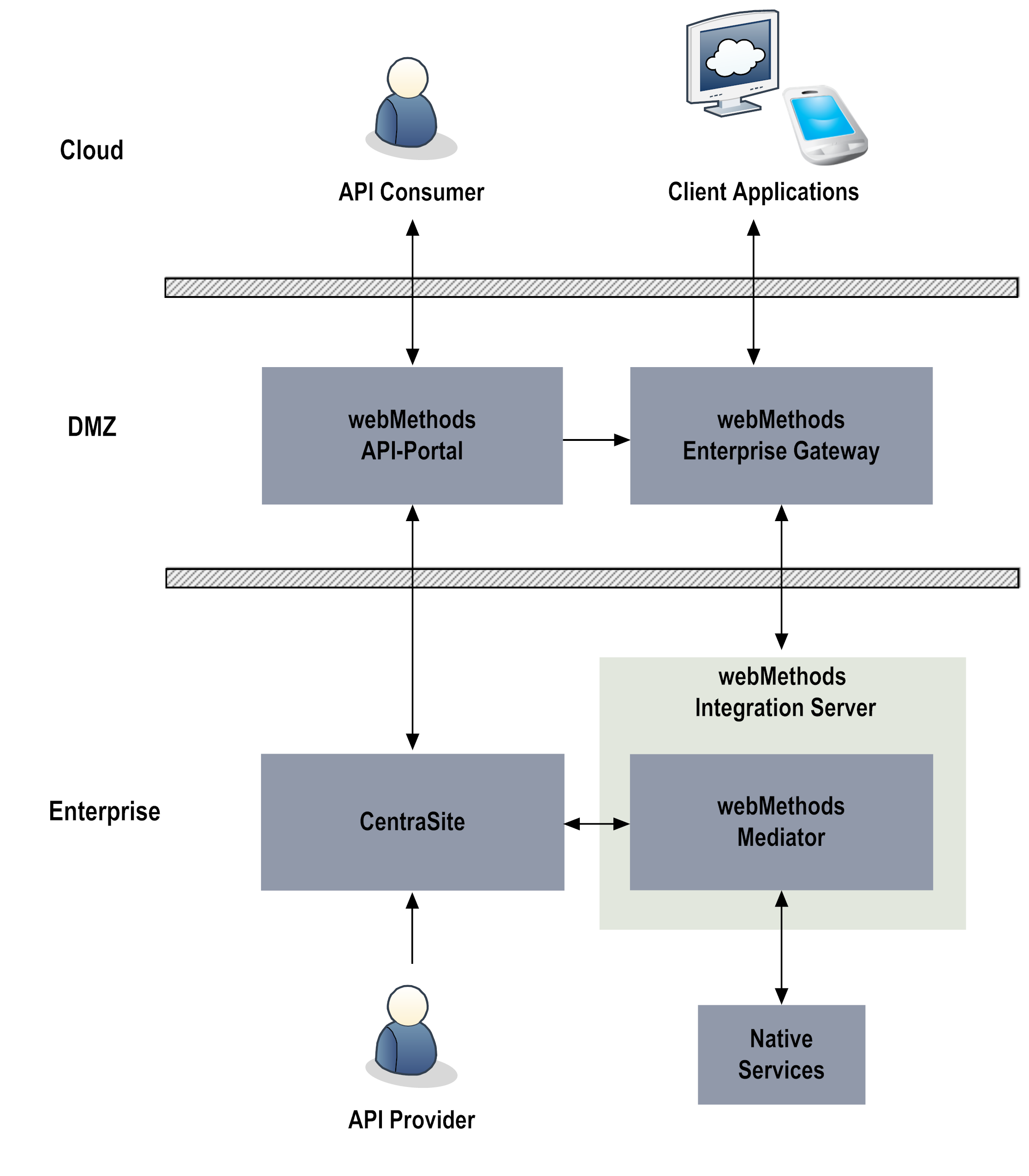What Is webMethods API-Portal?
webMethods API-Portal is a web-based, self-service portal that enables an organization to securely expose APIs to external developers, partners, and other consumers for use in building their own apps on their desired platforms. API-Portal provides the following features:
 Branding and customization. API-Portal
Branding and customization. API-Portal administrators can customize their portal’s logo, colors, and fonts to match their organization’s corporate identity. Administrators can further customize their portal by modifying pages, incorporating widgets, and changing the appearance and organization of APIs in the gallery for easier discovery. For example, APIs in a large catalog can be grouped by business domain, free versus paid, or public versus B2B partner. APIs can also be flagged based on maturity level (for example, beta versus production or release).
 Support for SOAP and REST APIs. API-Portal
Support for SOAP and REST APIs. API-Portal supports traditional SOAP-based APIs as well as REST-based APIs. This support enables organizations to leverage their current investments in SOAP-based APIs while they adopt REST for new APIs.
 Quick, secure providing of access tokens.
Quick, secure providing of access tokens. Approval workflows in
CentraSite simplify the provisioning of API keys and OAuth2 credentials. These workflows enable the API provider to individually approve access token requests that developers submit from
API-Portal.
 Easy discovery and testing of APIs.
Easy discovery and testing of APIs. Full text search capabilities help developers quickly find APIs of interest. API descriptions and additional documentation, usage examples, and information about policies enforced at the API level provide more details to help developers decide whether to adopt a particular API. From there, developers can use the provided code samples and expected error and return codes to try out APIs they are interested in, directly from within
API-Portal, to see first-hand how the API works.
 Quick, secure onboarding of new users.
Quick, secure onboarding of new users. Easy to configure approval workflows in
API-Portal graphical user interface to define how the user onboarding should take place, with or without confirmations.
 Community support. API-Portal
Community support. API-Portal provides a collaborative community environment where API consumers can rate APIs and contribute to open discussions with other developers.
 Built-in usage analytics. API-Portal
Built-in usage analytics. API-Portal provides information about where visitors are coming from, how many visitors become registered users, how many provisioned access tokens are actually used, what pages gather the most interest, and which APIs are more popular than others. This information is available by way of dashboards to API providers who have an API administrator role in
API-Portal. With this information, providers can understand how their APIs are being used, which in turn can help identify ways to improve their users’ portal web experience and increase API adoption.
The following diagram illustrates a typical scenario of products that make up the webMethods API management product suite.
In this scenario, webMethods API management suite products include the following:
 webMethods API-Portal
webMethods API-Portal. In
API-Portal, API consumers browse the catalog of APIs that a provider has published. When the consumer finds an API of interest, the consumer can sign up and request an access token to download the API for further investigation and testing.
API providers who have an API administrator role in API-Portal can also view dashboards containing details about API run-time usage.
Provided with each API-Portal installation is a sample portal called SAGTours. The SAGTours sample provides an end-to-end scenario using CentraSite, webMethods Mediator, and API-Portal to demonstrate how the fictitious company SAGTours has customized the content as well as the look and feel of an out-of-the-box API-Portal. For details about installing the SAGTours demo and using it as a basis for customizing your own portal, see webMethods API-Portal Online Help.
 CentraSite
CentraSite.
CentraSite provides a registry and repository for APIs and offers complete design-time governance of those APIs. API providers add APIs to
CentraSite by defining the APIs and their associated resources as objects. When APIs are ready to be made available to consumers, API providers publish the APIs from
CentraSite to
API-Portal.
CentraSite administrators do the following API management tasks:

Register instances of
API-Portal.

Manage API provider and API consumer user accounts.

Manage the API catalog.

Deploy virtualized APIs to
webMethods Mediator.

Configure policies to be enforced at run time.

Manage API and OAuth2 keys and API access tokens.
When API providers add API services to CentraSite as assets, the providers can attach supporting documents to the API assets. Examples of such documents include input files containing WSDL or schema definitions, programming guides, sample code, legal notices and terms of use, and associated contracts and plans. When the APIs are published from CentraSite to API-Portal, these supporting documents are published to API-Portal as well.
 webMethods Mediator
webMethods Mediator.
Mediator provides complete run-time governance of APIs published to
API-Portal.
Mediator acts as an intermediary between service consumers and service providers.
Mediator also enforces access token and operational policies such as security policies for run-time requests between consumers and native services. Using
Mediator, API providers can do the following:

Enforce security, traffic management, monitoring, and SLA management policies.

Transform requests and responses into expected formats as necessary.

Perform routing and load balancing of requests.

Collect run-time metrics on API consumption and policy evaluation.
 webMethods Integration Server
webMethods Integration Server.
Integration Server hosts
Mediator and initiates connections to
webMethods Enterprise Gateway.
Integration Server also orchestrates the services and provides the connection to back-end systems.
 webMethods Enterprise Gateway
webMethods Enterprise Gateway.
Enterprise Gateway protects the APIs on
Mediator and other
webMethods products installed behind the firewall from malicious attacks initiated by external client applications. Administrators can secure traffic between API consumer requests and the execution of services on
Mediator by doing the following:

Filter requests coming from particular IP addresses and blacklist specified IP addresses.

Detect and filter requests coming from particular mobile devices.

Avoid additional inbound firewall holes through the use of reverse invoke.
